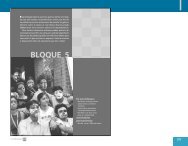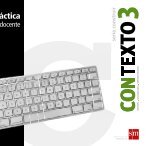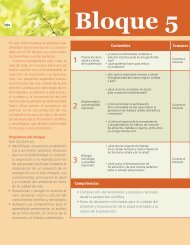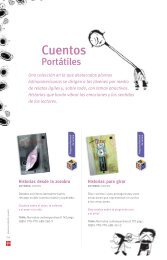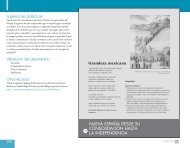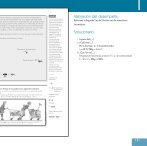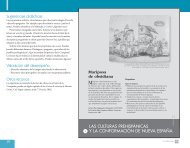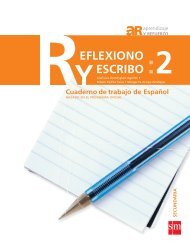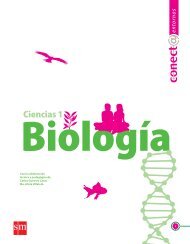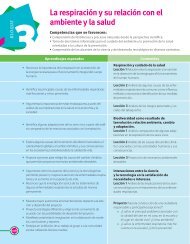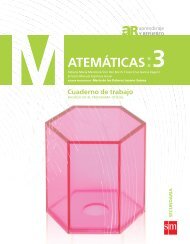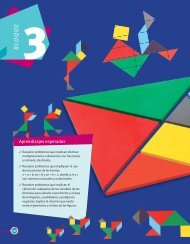Unit 2 - Secundaria SM
Unit 2 - Secundaria SM
Unit 2 - Secundaria SM
You also want an ePaper? Increase the reach of your titles
YUMPU automatically turns print PDFs into web optimized ePapers that Google loves.
Lesson 14 Safe Cycling<br />
Funciones: Hablar de reglas y normas de seguridad.<br />
Lenguaje: Riders must wear high visibility clothing and a<br />
helmet. Do not race cars.<br />
Vocabulario: clothing, cycle path, cyclist, helmet, high<br />
visibility, low visibility, rider; allow, avoid, hit, overtake<br />
¡Comencemos!<br />
78<br />
Divida la clase en parejas. Solicite a los alumnos que escriban<br />
en sus cuadernos tres situaciones peligrosas para los ciclistas:<br />
A car can run over you when you ride your bicycle. Luego,<br />
pida que lean sus oraciones a su pareja y que respondan<br />
con una instrucción de seguridad: You must use a cycle path.<br />
1 Experience it!<br />
a. Pida a los alumnos que vean el folleto y ayúdelos a contestar<br />
las preguntas.<br />
b. Solicite a los alumnos que lean el folleto y que escriban al<br />
lado de cada pregunta el número de la regla que la contesta.<br />
c. Ponga el Track 17. Pida a los alumnos que escuchen el<br />
diálogo, que numeren las reglas del folleto en el orden en que<br />
Nick las menciona y que marquen con un tache la regla que<br />
no menciona.<br />
Track 17<br />
Nick: OK, Carol. Listen up. This<br />
is very important. You have<br />
to wear a helmet and high<br />
visibility clothing so motorists<br />
can see you.<br />
Carol: OK. I have a helmet and I<br />
can wear my yellow jacket.<br />
Nick: That’s good. Now, here are<br />
some lights for your bike.<br />
Carol: Cool.<br />
Nick: You must use lights when<br />
there is low visibility. The red<br />
light is for the back of your bike<br />
and the white light is for the<br />
front.<br />
<strong>Unit</strong> 2 Lesson 14<br />
Carol: Can you put them on for<br />
me?<br />
Nick: No problem. Now,<br />
remember. You must use the<br />
cycle path.<br />
Carol: OK, but what happens if<br />
there isn’t a cycle path?<br />
Nick: You have to be extra careful.<br />
You must let cars pass you<br />
easily and you mustn’t pass too<br />
close to parked cars.<br />
Carol: Why not?<br />
Nick: Because someone can hit<br />
you with the door.<br />
78<br />
17<br />
Lesson 14 Safe Cycling<br />
1 Experience it!<br />
a. With your teacher, look at the pamphlet and answer the questions.<br />
1. Where would you see this kind of pamphlet?<br />
2. Who do you think it is for?<br />
b. Read the pamphlet. Write the number of the rule that answers the question.<br />
1. Which rule tells the cyclist where to ride? 2<br />
2. Which rule tells the cyclist what to wear? 1<br />
3. Which rules tells the cyclist what not to do? 3, 5<br />
c. Listen to the dialogue. Number the rules in the pamphlet in the order Nick mentions them and<br />
put a cross next to the rule he doesn’t mention.<br />
<br />
<br />
<br />
<br />
<br />
1<br />
<br />
<strong>Unit</strong> 2 Lesson 14<br />
<br />
<br />
<br />
<br />
2<br />
X



